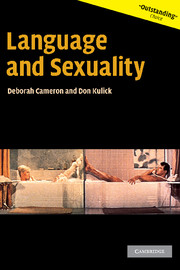Book contents
- Frontmatter
- Contents
- Preface
- 1 Making connections
- 2 Talking sex and thinking sex : the linguistic and discursive construction of sexuality
- 3 What has gender got to do with sex? Language, heterosexuality and heteronormativity
- 4 Sexuality as identity: gay and lesbian language
- 5 Looking beyond identity: language and desire
- 6 Language and sexuality: theory, research and politics
- Notes
- Bibliography
- Index
2 - Talking sex and thinking sex : the linguistic and discursive construction of sexuality
Published online by Cambridge University Press: 05 September 2012
- Frontmatter
- Contents
- Preface
- 1 Making connections
- 2 Talking sex and thinking sex : the linguistic and discursive construction of sexuality
- 3 What has gender got to do with sex? Language, heterosexuality and heteronormativity
- 4 Sexuality as identity: gay and lesbian language
- 5 Looking beyond identity: language and desire
- 6 Language and sexuality: theory, research and politics
- Notes
- Bibliography
- Index
Summary
In the film When Harry Met Sally there is a famous scene in which the female protagonist Sally apparently has an orgasm as she sits fully clothed at a table in the middle of a busy diner. In fact, both the man she is with, Harry, and the audience watching the action on screen know that she is faking it, to demonstrate that you can't tell the difference between a competent performance of an orgasm and the real thing. Part of the joke is the surprise, amusement and embarrassment her performance causes other customers in the diner, who cannot be sure whether the orgasm is real or faked. Also part of the joke is the chagrin of the man for whose benefit the performance is being put on; for if this is not a real orgasm, perhaps the female orgasms he has been party to in more intimate circumstances were not real either.
This scene provides an illustration of what is meant by ‘the discursive construction of sexuality’. The man who believes that you can always tell whether a woman's orgasm is genuine is holding on to one of our most cherished beliefs about sex: that the body does not lie. According to this view, the outward expression of orgasm comes directly from the inner physical processes and sensations of orgasm, and in the absence of the physical stimulus the outward expression cannot be convincing.
- Type
- Chapter
- Information
- Language and Sexuality , pp. 15 - 43Publisher: Cambridge University PressPrint publication year: 2003
- 1
- Cited by



